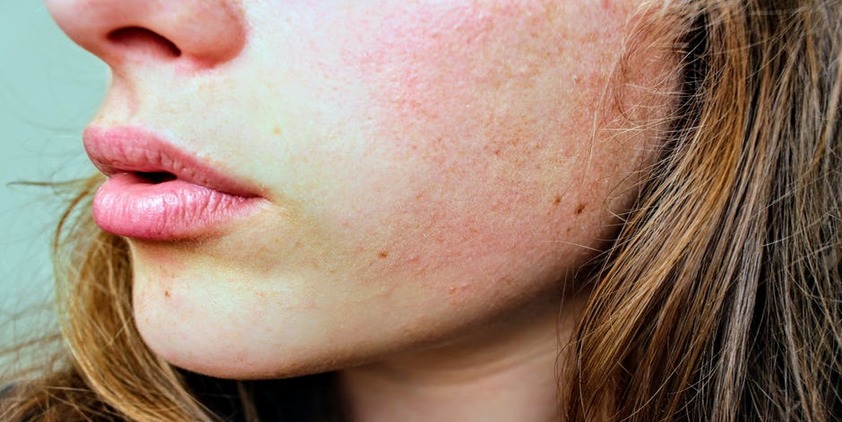

October 2, 2018 | Categories: Beauty & Skin Care, Health
If your skin appears red and blotchy it may be hard to pinpoint the exact cause, depending on if the flushing was immediate, gradual over weeks and months, or you think you’ve always had more redness on your face. Some people naturally blush more than others, some people may be experiencing flushing from being overheated or sun exposure. Others could be having an allergic reaction to a skin care-product or even food they ate, or it could be the common skin condition rosacea.
Though harsh ingredients in your skin-care products and dry sky can cause redness, the most common cause of persistent redness on the face would be rosacea, says Andrew Ordon, MD, Board Certified Plastic Surgeon, and co-host on ‘The Doctors.’ According to the National Rosacea Society, an estimated 16 million Americans have rosacea, but only a small number of them are being treated. [source: Rosacea.org]
Rosacea usually occurs on the forehead, chin, cheeks, nose, and can also occur on the upper back and upper chest. Swelling, dilated blood vessels create the appearance of redness.
While rosacea does affect men and women, it usually appears in women over 30, and is most commonly diagnosed in women in their 40s and 50s. It’s also likely to flare up the week before women get their periods, just as acne would.
While doctors still aren’t sure what causes rosacea (it’s genetic), for a lot of people, things that make your face flush worsen rosacea. Dr. Ordon suggests identifying and avoiding the triggers that may make it worse, like stress and sun exposure. Other proven rosacea triggers could be: alcohol, spicy foods and drinks, hot foods (temperature wise), windy conditions, hot weather, cold weather, humid weather, hot baths, saunas, heavy exertion, exercise, and sudden changes in emotion—like embarrassment or an outburst of laughter.
Laser treatments
One of the best ways to treat rosacea is with a laser, says Dr. Ordon. “We have specific lasers that target that color of redness, and in my practice, I use what’s called a pulsed-dye laser which specifically targets past your lesions such rosacea and acne. It’s good on red scars.” Lasers and intense pulsed light therapy help reduce visible blood vessels and severe background redness. You may need to attend several sessions to get the desired results, but also know that touch-up sessions may be needed later since the underlying disease is still present.
Learn how to control stress
Stress is a big trigger for many rosacea sufferers. In a survey of rosacea patients affected by stress, most of those using stress management techniques said they had successfully reduced their flare-ups. Get a handle on stress by practicing relaxation techniques, such as meditation, deep-breathing exercises, and visualizing yourself in a calm, serene setting.
Limit time in the sun
Since sun exposure often worsens rosacea in many people, Dr. Ordon recommends putting on sunscreen when outdoors and wearing caps with visors and sunglasses to minimize sun exposure. Try to stay indoors when the sun is at its highest from 10 a.m. to 2 p.m. These habits will help minimize rosacea outbreaks and protect your skin.
Try skin calming masks and creams
You may want to try some skin calming masks from specialty skin care lines that are designed to help soothe rosacea sufferers’ red skin. Some brands on the market include Dermalogica’s ultracalming™ line, Kate Somerville’s Rosacea Skin Care products, and Murad Redness Therapy® to name a few. Check with your dermatologist to see which products he/she recommends for your skin.
Mask redness with makeup
Women may choose to cover up rosacea with makeup. “That’s not really a cure, but it works like a charm and can be a quick resolution,” says Dr. Ordon.
Choose makeup products that are oil-free and have fewer ingredients to minimize the chance it’ll further irritate your skin, suggests an article on TotalBeauty.com. Always test the product on your arm first to ensure you’re not allergic to it. The article suggests using mineral powder makeup since it doesn’t contain skin-irritating ingredients and is lighter on your skin. Start with a green primer base to tone down redness and then top with yellow-toned mineral foundation.
Discover natural cures for your skin problems.
How to treat irritated skin
If you think the cause of your red skin is an allergic reaction or irritation from face products, use mild nonsoap cleansers and hypoallergenic products, suggests Mona Gohara, MD, associate clinical professor, Yale School of Medicine, Department of Dermatology. “If this occurs it is always best to discontinue all products, re-introducing them one week to 10 days apart. This can help identify the culprit,” she says. See a dermatologist for specialized allergy testing and topical creams that can help fix the problem. [source: Dr. Gohara]
Read the full article on Howstuffworks.
Leave a Reply